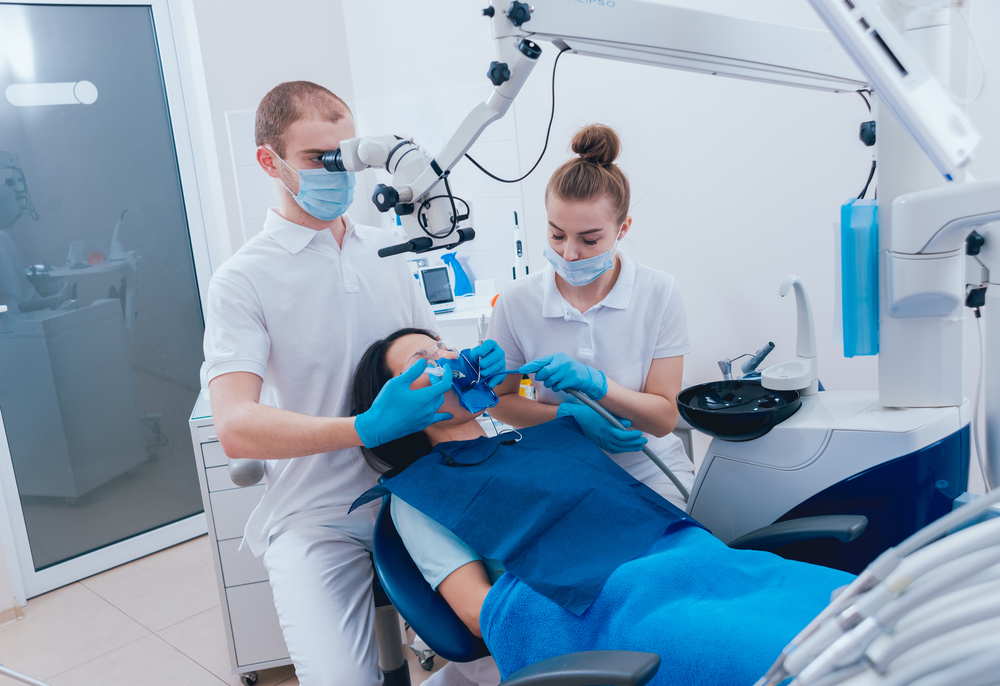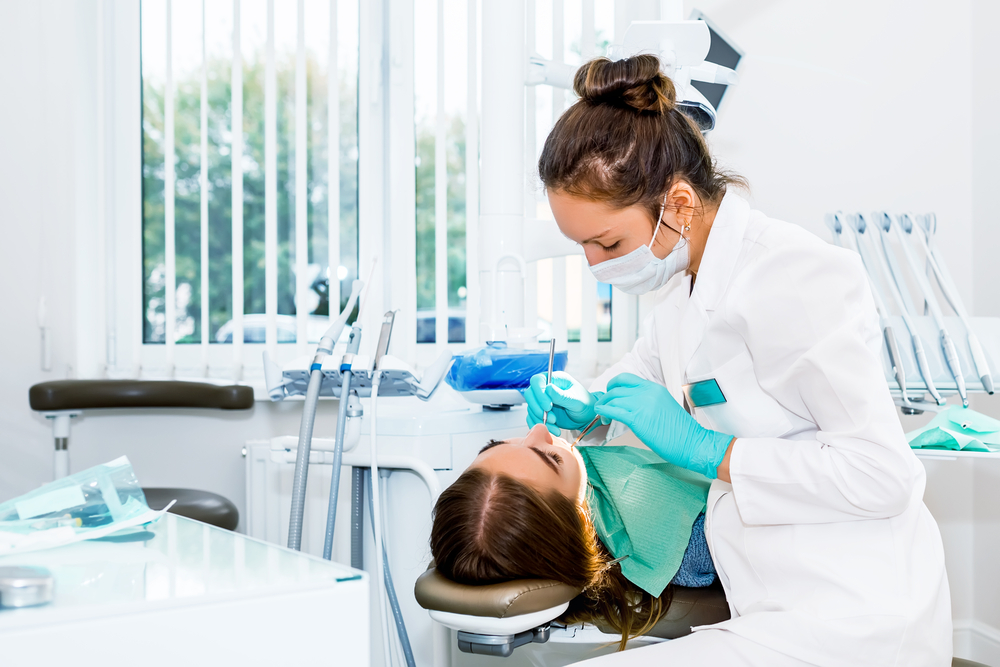1812 E. Broadway St.
Pearland, TX 77581
Root canal therapy is one of the most common treatments for tooth decay, but the traditional approach involves surgery, which can be intimidating for many patients. However, non-surgical root canal treatment provides a painless and effective alternative that preserves your natural tooth structure while eliminating infected tissue.
At Pearland Dental Group, Dr. Rushi Dave and Dr. Mili Shah are committed to offering comfortable, state-of-the-art dental care to patients throughout Pearland, League City, Pasadena, and Galena Park, TX. Our advanced techniques and compassionate approach ensure you receive the highest quality care for your dental needs.
Have questions about non-surgical root canal options? Call our Pearland, TX, dental practice today at (281) 993-9900 to speak with our friendly team. You can also learn more about this non-surgical alternative by reading our comprehensive guide below.
When considering where to receive non-surgical root canal therapy, Pearland Dental Group stands out for our comprehensive approach to care. Our practice employs state-of-the-art diagnostic tools, including digital radiography and 3D imaging, allowing Dr. Dave and Dr. Shah to visualize your tooth’s internal anatomy with unprecedented precision.
This technology, combined with our doctors’ extensive training and experience in endodontic procedures, enables more accurate treatment planning and consistently excellent outcomes for our patients. We’ve designed our treatment protocols with patient comfort as a priority, offering sedation options when needed and creating a relaxing environment that puts patients at ease.
Our team doesn’t just treat the immediate problem—we take a whole-mouth health perspective, addressing underlying causes while preserving long-term oral health. Serving patients throughout Pearland, League City, Pasadena, and Galena Park, TX, we offer flexible scheduling options to accommodate your busy life, including emergency appointments for dental pain. Experience the Pearland Dental Group difference by calling (281) 993-9900 today.
Non-surgical root canal treatment is a minimally invasive procedure designed to treat tooth decay and save the natural tooth from tooth extraction. Unlike conventional root canal therapy, which may involve surgical approaches for complex cases, non-surgical root canal treatment is performed without making any incisions or cuts to the surrounding tissue.
During this procedure, our Pearland general dentists use specialized tools to access and remove the infected pulp from inside the tooth, thoroughly clean the root canal system, and fill it with biocompatible materials that prevent further infection. The science behind this approach focuses on preserving maximum tooth structure while effectively eliminating bacterial infection.
The pulp tissue inside your tooth contains blood vessels, nerves, and connective tissue that can become infected due to deep decay, repeated dental procedures, cracks, or trauma. When this occurs, bacteria multiply within the pulp chamber, causing increased pressure and pain as they spread throughout the root canal system. Non-surgical root canal therapy addresses this infection at its source without disturbing the surrounding tissues.
Want to know if you’re a candidate for this minimally invasive procedure? Contact Pearland Dental Group at (281) 993-9900 to schedule your evaluation.
Non-surgical root canals offer several significant advantages over surgical approaches, including:
Contrary to outdated stereotypes, modern non-surgical root canal therapy isn’t painful and typically requires only a local anesthetic. The procedure actually relieves pain by removing the infected pulp tissue that causes discomfort. Patients remain comfortable during treatment and experience minimal discomfort afterward. Our doctors utilize the latest anesthetic techniques to ensure your comfort throughout the entire process.
Because it’s a minimally invasive procedure that preserves tooth structure and doesn’t impact surrounding tissues, patients can usually resume normal activities immediately after treatment. There’s minimal swelling, and most patients return to their regular routine the same day.
Non-surgical root canal treatment allows you to keep your natural tooth, which is always preferable to extraction. Your natural teeth are better for biting, chewing, and maintaining proper alignment than artificial alternatives. This preservation helps maintain jawbone density and prevents shifting of adjacent teeth.
Non-surgical root canal treatment has a remarkably high success rate—approximately 95 percent when performed by experienced specialists like Dr. Dave and Dr. Shah. With proper care, teeth that have undergone non-surgical root canal therapy can last a lifetime.
While the initial cost may seem significant, non-surgical root canal treatment is actually more economical in the long run compared to extraction followed by implant placement or bridge work. It eliminates the need for ongoing treatments that would be necessary with tooth replacement options.
Non-surgical root canal treatment is typically recommended for patients whose tooth decay or infection hasn’t progressed to extremely advanced stages where the tooth structure is severely compromised.
The following factors may indicate your candidacy for this non-invasive treatment:
If you’re experiencing a severe toothache, particularly when chewing or applying pressure to the affected tooth, this may indicate that the tooth’s pulp is inflamed or infected. The nerve tissue inside the pulp becomes increasingly sensitive as the infection progresses, causing sharp, throbbing pain that often worsens at night.
Prolonged sensitivity to hot or cold temperatures, even after the stimulus has been removed, can signal pulp damage. This happens because the infected pulp’s nerve endings become hypersensitive to thermal changes, creating lingering discomfort that doesn’t subside quickly.
A discolored or darkened tooth often indicates a dying pulp, as the breakdown of pulp tissue releases compounds that stain the dentin from within. This discoloration typically appears grayish-black or yellowish-brown and doesn’t respond to external whitening treatments.
Swelling, tenderness, or a persistent pimple-like formation (fistula) on the gums around a tooth indicates an infection that has spread from the tooth pulp to the surrounding tissues. These symptoms occur when bacteria and their byproducts exit through the root tip into the surrounding bone and tissue.
X-rays may reveal darkened areas at the root tip (periapical radiolucencies) that indicate infection has spread beyond the tooth into the surrounding bone. These lesions develop as your immune system attempts to contain the infection, creating visible changes in bone density.
Experiencing any of these symptoms? Don’t wait for the pain to worsen. Call Pearland Dental Group at (281) 993-9900 to schedule an urgent assessment.
The non-surgical root canal procedure typically takes about one to two hours in our dental office, depending on the complexity of your specific case. Here’s what to expect during your visit:
Before beginning treatment, Dr. Dave or Dr. Shah will conduct a thorough examination, including digital radiographs, to assess the extent of infection and plan the precise approach needed for your tooth’s unique anatomy.
Your comfort is our priority. The dentist will completely numb the area around the affected tooth using a local anesthetic. The anesthetic blocks the nerve pathways that transmit pain signals, ensuring you remain comfortable throughout the procedure.
A thin, flexible rubber sheet called a dental dam will be placed around the tooth. This important step prevents saliva and bacteria from the mouth from contaminating the treatment area and protects your airway from the small instruments and solutions used during the dental procedure itself.
Using precision instruments, your dentist will create a small access opening through the crown of the tooth to reach the pulp chamber. For front teeth, this is typically done through the back surface, while for molars, the access is created through the chewing surface.
Special flexible nickel-titanium files of increasing diameter are used to carefully remove the infected pulp tissue and shape the canal system. These advanced instruments can navigate the natural curves of your tooth and root canals, while preserving maximum tooth structure.
Electronic apex locators and digital radiography help determine the exact length of each canal, ensuring complete cleaning without extending beyond the root tip—a critical factor in treatment success.
The canals are thoroughly cleaned using antimicrobial irrigating solutions like sodium hypochlorite (bleach) that eliminate bacteria and dissolve remaining tissue. Advanced techniques such as sonic or ultrasonic activation may be used to ensure the solution reaches all areas of the complex canal system.
Once the canals are clean and shaped, they are dried and filled with gutta-percha, a biocompatible rubber-like material that seals the canal space. A special adhesive cement ensures a complete seal between the gutta-percha and the canal walls, preventing future bacterial invasion.
Depending on your specific case, your tooth may receive a temporary filling, or in some cases, a permanent restoration may be placed immediately. For most teeth that have undergone root canal therapy, a crown is eventually recommended to provide structural support and prevent fracture.
Ready to address your dental pain with our gentle, effective approach? Schedule your appointment at Pearland Dental Group by calling (281) 993-9900.
After your non-surgical root canal treatment at Pearland Dental Group, patients can usually resume their normal activities immediately. However, it’s crucial to follow Dr. Dave’s or Dr. Shah’s instructions for the care and maintenance of the treated tooth:
Contact our office immediately if you experience:
Have questions about your recovery? Don’t hesitate to call Pearland Dental Group at (281) 993-9900 for guidance.
Non-surgical root canal treatment is not painful, contrary to outdated perceptions and old jokes. Modern techniques and effective, local anesthesia and anesthetics ensure patients remain comfortable throughout the entire procedure, experiencing only mild pressure sensations rather than pain.
In fact, most patients report that the procedure is no more uncomfortable than having a routine filling placed, and many actually experience immediate relief from the severe pain that brought them to our office. Our doctors at Pearland Dental Group prioritize your comfort and will check frequently to ensure you’re feeling at ease throughout the treatment.
Non-surgical root canal treatment typically takes between 60 to 90 minutes to complete for a standard case, though more complex situations may require additional time. The duration depends on several factors, including the number of canals (molars have three to four, while front teeth usually have just one), the severity of infection, and the complexity of the root anatomy.
At Pearland Dental Group, we schedule appointments with adequate time to complete your treatment thoroughly without rushing, ensuring optimal clinical outcomes while keeping your comfort in mind.
Most dental insurance plans provide significant coverage for non-surgical root canal therapy as it’s considered a necessary procedure to treat infection and preserve natural teeth. Coverage typically ranges from 50 percent to 80 percent of the procedure cost, depending on your specific plan’s provisions and annual maximums.
The Pearland Dental Group administrative team is experienced in working with insurance providers and will verify your benefits before treatment, providing you with a clear understanding of your estimated out-of-pocket expenses. For patients without insurance coverage, we offer various payment options and financing plans to make this essential treatment accessible.
A tooth that has undergone non-surgical root canal treatment can last a lifetime with proper care and maintenance. Research shows success rates exceeding 95 percent for properly performed procedures, especially when followed by appropriate restoration such as a crown.
The long-term success depends on several factors, including the quality of the root canal procedure, the timely placement of a temporary or permanent filling restoration, good oral hygiene practices, and regular dental check-ups. At Pearland Dental Group, our doctors’ advanced training and meticulous attention to detail maximize the longevity of your treated tooth, allowing you to maintain your natural smile for years to come.
Non-surgical root canal treatment at Pearland Dental Group offers a comfortable, effective solution for saving infected teeth and eliminating pain. Our advanced techniques, experienced doctors, and patient-centered approach ensure you receive exceptional care throughout your treatment journey.
Dr. Rushi Dave and Dr. Mili Shah serve patients throughout Pearland, League City, Pasadena, and Galena Park, TX, with compassionate, high-quality dental care. Don’t let fear or misconceptions about root canal therapy prevent you from addressing dental pain and saving your natural teeth.
Schedule a consultation with our team by calling (281) 993-9900 to see if non-surgical root canal treatment in Pearland, TX, is right for you. With proper treatment and aftercare, you can enjoy a healthy, pain-free smile for years to come.





Our clinic offers all kinds of services and constantly study new
technology to add new custom services to the list
Phone: (281)993-9900
Address: 1812 E. Broadway St. Pearland, TX 77581
Copyright © 2021 Pearland Dental Group | Managed by Now Media Group